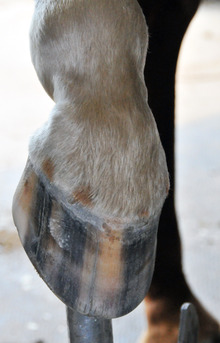The exact causes and disease processes involved in laminitis are still unclear. Laminitis, in its simplest form, is inflammation of the sensitive layers (laminae) of the hoof resulting in pain, inflammation and, in some cases, damage to the laminae.

Low down on equine laminitis
Equines come down down with laminitis for many reasons: too much spring grass, weight bearing, equine metabolic syndrome, equine Cushing's disease, and endotoxemia.
© 2013 by April Raine
The laminae are interwoven specialised ‘leaves’ of tissue which suspend the pedal bone within the hoof.
In very mild cases, appropriate treatment will resolve the problem with no lasting effect. If the inflammation is more severe and progressive, the sensitive laminae may lose their blood supply, resulting in loss of support between the pedal bone and horny hoof wall. This can lead to separation of the pedal bone from the hoof with rotation and/or sinking of the bone within the hoof. In severe cases penetration of the sole by the tip of the pedal bone can follow.
There are many different reasons why horses come down with laminitis, including pasture-associated (for example too much spring grass), weight bearing laminitis (too much weight placed on one foot because of pain in the opposite one), equine metabolic syndrome, equine Cushing’s disease, and endotoxemia.
The exact reason as to why some horses develop laminitis and others do not is still unclear, although we now have more information about the risk factors and underlying causes. More recent research has demonstrated underlying metabolic disorders play an important role in a much higher percentage of cases than previously thought.
What equine owners should know about laminitis:
- Laminitis is one of the most common conditions which affects horses, ponies and donkeys, and can cause long-term severe pain and lameness
- Laminitis refers to inflammation, loss of blood supply and damage to the sensitive laminae within the foot. They form the vital attachment of the pedal bone to the hoof wall
- The exact mechanisms by which laminitis is caused are not known, but we do know about risk factors which predispose horses to getting the condition
- Pasture-associated laminitis is common when lush green grass is present, so avoiding too much grass for at risk animals is important
- Underlying metabolic disorders, such as equine Cushing’s disease and equine metabolic syndrome are important risk factors and treating these can reduce the risk of a horse getting laminitis and also aid in the recovery of horses with the condition
- Appropriate diet and exercise and avoiding obesity are important to prevent laminitis
Preventing Laminitis in equines
Preventing laminitis is accomplished through proper horse management, with consistent practices as to feeding, routines, disease prevention, and good health care.
Avoiding feeding excesses, making sure horses and donkeys and other equines are kept at a reasonable weight, and limiting time in pastures during exceptionally lush growth will help prevent the development of laminitis. Horses should have unlimited access to fresh, clean water, except immediately after exercise when the amount and temperature should be regulated.
When making changes to routines and amount of exercise, go slowly and progressively. Avoid excessive concussion to feet and work-outs on rocky, hard, uneven terrain.
Illnesses, digestive upsets, and primary foot diseases should be addressed immediately before complications can occur that might lead to secondary illnesses or conditions, such as laminitis.
Learn more about Laminitis
